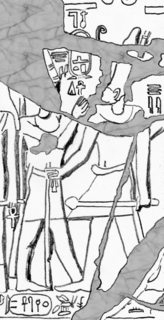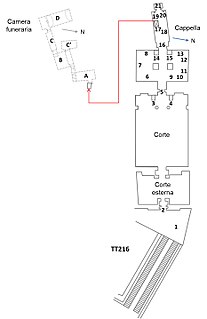| Neferhotep in hieroglyphs | ||||
|---|---|---|---|---|
| ||||
Neferhotep is an ancient Egyptian given name. Notable bearers were:

Ancient Egypt was a civilization of ancient North Africa, concentrated along the lower reaches of the Nile River in the place that is now the country Egypt. Ancient Egyptian civilization followed prehistoric Egypt and coalesced around 3100 BC with the political unification of Upper and Lower Egypt under Menes. The history of ancient Egypt occurred as a series of stable kingdoms, separated by periods of relative instability known as Intermediate Periods: the Old Kingdom of the Early Bronze Age, the Middle Kingdom of the Middle Bronze Age and the New Kingdom of the Late Bronze Age.
- Neferhotep I, pharaoh of the 13th Dynasty
- Neferhotep II, pharaoh of the 13th Dynasty, see Mersekhemre Ined
- Neferhotep III, pharaoh of the 16th Dynasty
- Neferhotep (scribe of the great enclosure) during the 13th Dynasty
- Neferhotep, owner of Theban tomb TT6
- Neferhotep "the Younger", owner of TT216 and grandson of the above
- Neferhotep, chief scribe of Amun, owner of TT49
- Neferhotep, god's father of Amun-Ra, owner of TT50

Khasekhemre Neferhotep I was an Egyptian pharaoh of the mid Thirteenth Dynasty ruling in the second half of the 18th century BC during a time referred to as the late Middle Kingdom or early Second Intermediate Period, depending on the scholar. One of the best attested rulers of the 13th Dynasty, Neferhotep I reigned for 11 years.

Mersekhemre Ined was a pharaoh of the late 13th Dynasty, possibly the thirty-fifth king of this dynasty. As such he would have reigned from Memphis over Middle and Upper Egypt for a short time either during the early or mid-17th century, from 1672 until 1669 BC or from 1651 until 1648 BC. He may be the same king as Mersekhemre Neferhotep II.

Sekhemre Sankhtawy Neferhotep III Iykhernofret was the third or fourth ruler of the Theban 16th Dynasty, reigning after Sobekhotep VIII according to egyptologists Kim Ryholt and Darrell Baker. He is assigned a reign of 1 year in the Turin Canon and is known primarily by a single stela from Thebes. In an older study, Von Beckerath dated Neferhotep III to the end of the 13th Dynasty.
The name also was an epithet of the lunar god Khonsu.

Khonsu is the Ancient Egyptian god of the moon. His name means "traveller", and this may relate to the nightly travel of the moon across the sky. Along with Thoth he marked the passage of time. Khonsu was instrumental in the creation of new life in all living creatures. At Thebes he formed part of a family triad with Mut as his mother and Amun his father.
| This disambiguation page lists articles about people with the same name. If an internal link led you here, you may wish to change the link to point directly to the intended article. |













